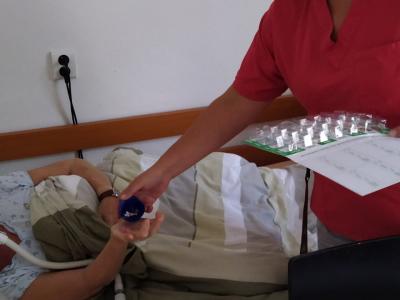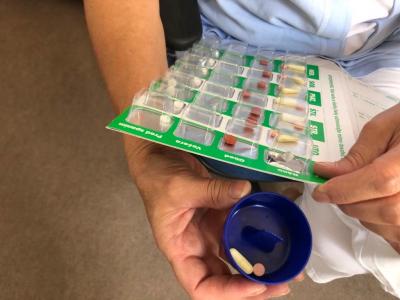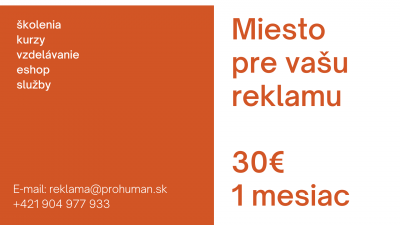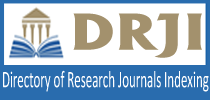Limity a možnosti manažmentu sociálnych služieb spojené s ubytovaním
Abstract:
Introduction: Nursing and residential homes facility should maintain a current, accurate and reliable record of the drugs prescribed and given to a resident. The correct use of a medication chart can meet this requirement. We dealt with the issue in which we specify that Nursing and residential homes facility should maintain a current, accurate and reliable record of the drugs prescribed and given to a resident.
Objective: The aim of the work was to specify the correct use of a medication chart. The hard-copy of Nursing and Residential homes Medication Chart aims to provide a standard form for the prescription, dispensing and administration of drugs.
Methodology: The partial objectives include comprehensive record in drug use that should facilitate communications between health professionals.
Results: Medication record charts (medication administration charts MAR) reduce the risk of prescribing, dispensing and administration error through standardised presentation of medicines information for an individual patient. It also standardises the way medicines information is presented in all high-risk healthcare settings. Conclusion: Based on practice results, we concluded that benefts of Medication records charts or at least a series of best practice principles for the design and use of a Medication Chart, comes from having a greater awareness that the prescribing process can result in direct patient harm and a greater awareness of the strategies and processes to minimise this harm.
Key words: Medication record charts, medication administration charts, MAR, nursing and residential home, nurse.
Abstrakt:
Úvod: Zariadenia sociálnych služieb by mali viesť aktuálny, presný a spoľahlivý záznam o predpísaných liekoch a ich podávaní klientom/pacientom. Správne použitie liekovej schémy môže splniť túto požiadavku. Zaoberali sme sa otázkou, v ktorej uvádzame, že zariadenia sociálnych služieb by mali viesť aktuálny, presný a spoľahlivý záznam o liekoch predpísaných a poskytovaných klientovi/pacientovi.
Cieľ: Cieľom práce bolo špecifikovať správne použitie liekovej schémy. Zariadenia sociálnych služieb a liekové záznamy majú za úlohu poskytnúť štandardnú formu v rámci predpisovania, vydávania a podávania liekov.
Metodika: Medzi čiastkové ciele patrí úloha komplexných záznamov o užívaní liečiv, ktoré by mal uľahčiť komunikáciu medzi zdravotníckymi pracovníkmi.
Výsledky: Tabuľky záznamov o liekoch znižujú riziko predpísania, výdaja a chyby pri podávaní liekov prostredníctvom štandardizovaného predkladania informácií o liekoch jednotlivým pacientom. Štandardizuje sa tiež spôsob prezentácie informácií o liekoch vo všetkých rizikových zdravotníckych zariadeniach.
Záver: Na základe výsledkov z praxe sme dospeli k záveru, že výhody záznamov o liekoch alebo aspoň série zásad osvedčených postupov pri navrhovaní a používaní liekovej schémy vychádzajú z väčšej informovanosti o tom, že proces predpisovania môže mať za následok priame poškodenie pacienta a tým sa zvyšuje väčšie povedomie o stratégiách a procesoch na minimalizovanie tohto poškodenia.
Kľúčové slová: Liekový záznam, zariadenia sociálnych služieb, sestra.
_0.album.jpg)
INTRODUCTION
A medication administration chart in a nursing or residential home as a communication tool between doctors, nurses, pharmacists, other health care professionals and hospitals regarding a resident's/patients medicines. It is used to direct how and when drugs are to be administered and as a record of their administration.
Ensuring a resident in a residential or nursing home receives the best therapy in an accurate and safe manner is a complex process involving many health professionals including doctors, pharmacists and nurses. One very important task of this process is the communication of the prescription to allow safe and accurate dispensing and administration. This communication can be made safer if parts of this communication processes are made with a better understanding of various safety principles and with some standardisation of these processes to minimise the possibilities of inadvertent any medication errors.
Unlike an individual's home, where he or she administers his or her own medicines, medicines in social services are usually managed by workers, although clients retain the right to administer their own medicines if possible. Drug management is a complex and multifactorial process and represents an underestimated and important element of residents care. It is a intensive process and has been shown to account for up to 40-50% of staff time in social services facilities (Alldred et al. 2009).
A medication administration chart in a residential and nursing homes is a safe communication tool between doctors, nurses, pharmacists and other health care professionals and hospitals regarding a resident’s medication. It is used to direct how and when drugs are to be administered and as a record of their administration by qualified nurses/staff.
Standards principles for medication management in nursing and residential facilities are that social services should ensure all residents have a current, accurate and reliable record of all medicines selected, prescribed, administered and used, to support safe prescribing and administration. The correct use of an appropriately designed medication administration chart is requirement.
Most nursing facilities use proprietary printed medication charts available from commercial printers, aged-care service company’s versions from agencies whose charts are able to be printed on site or from pharmacist.
Drug management is one of the most important functions for employees in social services facilities, nurses/qualified staff perform this role. There are usually four cycles of medication per day, which in most cases coincide with the client's meal time (8:00, 12:00, 16:00 and 20:00).Generally speaking, one employee will run a drug delivery cycle that can last anywhere between 30 minutes and two hours depending on the number of clients and the number of drugs administered in each facility (Alldred et al. 2009).The delivery of medicines in social care facilities has become more complex over the last 40 years due to the growing number of medicines and treatments available to treat clients with increasingly complex conditions and comorbidities. Medications are supplied by different pharmaceutical companies and may have different brands and packaging, which increases the complexity of drug administration. (Edwards 2015).
ISSUES WITH MEDICATION ADMINISTRATION CHARTS IN RESIDENTIAL OR NURSING HOMES
The proprietary printed charts used in nursing and residential homes are usually multiple-page booklets designed to last for periods of up to six months. Whereas patients, doctors, nurses and pharmacists are usually co-located in hospitals and can physically use the same chart, this is not the case in nursing and residential facilities. Their differing locations result in all paperwork needing to be copied and faxed or shared electronically between the facility, doctors and pharmacists. The multiple-page booklet format of the charts used in aged care complicates transmitting a comprehensive record of a resident’s current treatments.
Drugs can be supplied to residents of nursing and residential facilities in original packs dispensed by a pharmacist and labelled with instructions for administration or supplied in dose administration aids. These aids may be packed with a single drug per pack (unit dose) or with a number of drugs due to be simultaneously administered to the resident (multi dose). While dose administration aid has become common place in nursing and residential facilities, not all prescribed drugs can be packed together due to formulation, stability or regulatory restraints. This frequently results in the use of parallel supply systems of original packs and dose administration aids.
All jurisdictions require a registered or enrolled nurse to be responsible for the drugs given in a nursing and residential facility. However, in some circumstances, trained nursing assistants/ NVQ Level 3 are able to help residents to self-administer medicines. If supplied in an original pack, the nurse who administers a drug is required to verify it against the doctor’s order, select the correct quantity and record the administration on the MAR chart. If the drug is supplied in a dose administration aid, the staff member who assists a resident to self-administer or who administers the contents must sign for doing so without the responsibility of identifying each drug. Medication charts need to be able to accommodate these differences in packaging and the obligations for documentation.
Any scheduled drug ordered on a medication chart in a nursing and residential facility requires a separate prescription to be written to facilitate supply and, if the medicine is listed on the Medication List, to enable reimbursement of the pharmacist. There are risks associated with the duplication of a written medication order. There are also additional ‘clerical’ obligations and a potential for a delay in treatment. Any tardiness in writing a complete prescription may entail a delay in supply or payment and, if the prescription is never written, there will be no reimbursement of the cost.
The Rights of the Patients/Residents
1. Right to Appropriate Medical Care and Humane Treatment.
Every person has a right to health and medical care corresponding to his state of health, without any discrimination and within the limits of the resources, manpowerand competence available for health and medical care at the relevant time. The patient has the right to appropriate health and medical care of good quality. In the course of such, his human dignity, convictions, integrity, individual needs and culture shall be respected. If any person cannot immediately be given treatment that is medically necessary he shall, depending on his state of health, either be directed to wait for care, or be reffered or sent for treatment elsewhere, where the appropriate care can be provided. If the patient has to wait for care, he shall be informed of the reason for the delay. Patients in emergency shall be extended immediate medical care and treatment without any deposit, pledge, mortgage or any form of advance paymentfor treatment.
2. Right to Informed Consent.
The patient has a right to a clear, truthful and substantial explanation, in a manner and language understandable to the patient, of all proposed procedures, whether diagnostic, preventive, curative, rehabilitative or therapeutic, wherein the person who will perform the said procedure shall provide his name and credentials to the patient, possibilities of any risk of mortality or serious side effects, problems related to recuperation, and probability of success and reasonable risks.
Informed consent shall be obtained from a patient concerned if he is of legal age and of sound mind. In case the patient is incapable of giving consent and a third party consent is required. the following persons, in the order of priority stated hereunder, may give consent:
i. spouse;
ii. son or daughter of legal age;
iii. either parent;
iv. brother or sister of legal age, or
v. guardian

If a patient is a minor, consent shall be ottained from his parents or legal guardian. If next of kin, parents or legal guardians refuse to give consent to a medical or surgical proceoure necessary to save the life or limb of a minor or a patient incapable of giving consent, courts, upon the petition of the physician or any person interested in the welfare of the patient, in a summary proceeding, may issue an order giving consent.
3. Right to Privacy and Confidentiality.
The privacy of the patients must be assured at all stages of his treatment. The patient has the right to be free from unwarranted public exposure, except in the foHowing cases: a) when his mental or physical condition is in controversy and the appropriate court, in its discretion, order him to submit to a physical or mental examination by a physician; b) when the public health and safety so demand; and c) when the patient waives this right in writing.
The patient has the right to demand that all information, communication and records pertaining to his care be treated as confidential. Any health care provider or practitioner involved in the treatment of a patient and all those who have legitimate access to the patient's record is not authorized to divulge any information to a third party who has no concern with the care and welfare of the patient without his consent, except: a) when such disclosure will benefit public health and safety; b) when it is in the interest of justice and upon the order of a competent court; and c) when the patients waives in writing the confidential nature of such information; d) when it is needed for continued medical treatment or advancement of medical science subject to de-identification of patient and shared medical confidentiality for those who have access to the information.
Informing the spouse or the family to the first degree of the patient's medical condition may be allowed; Provided That the patient of legal age shall have the right to choose on whom to inform. In case the patient is not of legal age or is mentally incapacitated, such information shall be given to the parents, legal guardian or his next of kin.
4. Right to Information.
In the course of his/her treatment and hospital care, the patient or his/her legal guardian has a right to be informed of the result of the evaluation of the nature and extent of his/her disease, any other additional or further contemplated medical treatment on surgical procedure or procedures, including any other additional medicines to be administered and their generic counterpart including the possible complications and other pertinent facts, statistics or studies, regarding his/her illness, any change in the plan of care before the change is made, the person's participation in the plan of care and necessary changes before its implementation, the extent to which payment maybe expected from Philhealth or any payor and any charges for which the patient maybe liable, the disciplines of health care practitioners who will fumish the care and the frequency of services that are proposed to be furnished.
The patient or his legal guardian has the right to examine and be given an itemized bill of the hospital and medical services rendered in the facility or by his/her physician and other health care providers, regardless of the manner and source of payment.He is entitled to a thorough explanation of such bill.
The patient or hislher legal guardian has the right to be informed by the physician or his/her delegate of hisJher continuing health care requirements following discharge, including instructions about home medications, diet, physical activity and all other pertinent information to promote health and well-being.
At the end of his/her confinement, the patient is entitled to a brief, written summary of the course of his/her illness which shall include at least the history, physical examination, diagnosis, medications, surgical procedure, ancillary and laboratory procedures, and the plan of further treatment, and which shall be provided by the attending physician. He/she is likewise entitled to the explanation of, and to view, the contents of medical record of his/her confinement but with the presence of his/her attending physician or in the absence of the attending physician, the hospital's representative. Notwithstanding that he/she may not be able to settle his accounts by reason of financial incapacity, he/she is entitled to reproduction, at his/her expense, the pertinent part or parts of the medical record the purpose or purposes of which he shall indicate in his/her written request for reproduction. The patient shall likewise be entitled to medical certifICate, free of charge, with respect to his/her previous confinement.
5. The Right to Choose Health Care Provider and Facility.
The patient is free to choose the health care provider to serve him as well as the facility except when he is under the care of a service facility or when public health and safety so demands or when the patient expressly waives this right in writing.
The patient has the right to discuss his condition with a consultant specialist, at the patient's request and expense. He also has the right to seek for a second opinion and subsequent opinions, if appropriate, from another health care provider/practitioner.
6. Right to Self-Determination.
The patient has the right to avail himself/herself of any recommended diagnostic and treatment procedures.Any person of legal age and of sound mind may make an advance written directive for physicians to administer terminal care when he/she suffers from the terminal phase of a terminal illness: Provided That a) he is informed of the medical consequences of his choice; b) he releases those involved in his care from any obligation relative to the consequences of his decision; c) his decision will not prejudice public health and safety.
7. Right to Religious Belief.
The patient has the right to refuse medical treatment or procedures which may be contrary to his religious beliefs, subject to the limitations described in the preceding subsection: Provided, That such a right shall not be imposed by parents upon their children who have not reached the legal age in a life threatening situation as determined by the attending physician or the medical director of the facility.
8. Right to Medical Records.
The patient is entitled to a summary of his medical history and condition.He has the right to view the contents of his medical records, except psychiatric notes and other incriminatory information obtained about third parties, with the attending physician explaining contents thereof. At his expense and upon discharge of the patient, he may obtain from the health care institution a reproduction of the same record whether or not he has fully settled his financial obligation with the physician or institution concerned.
The health care institution shall safeguard the confidentiality of the medical records and to likewise ensure the integrity and authenticity of the medical records and shall keep the same within a reasonable time as may be determined by the Department of Health.
The health care institution shall issue a medical certificate to the patient upon request.Any other document that the patient may require for insurance claims shall also be made available to him within forty-fIVe (45) days from request.
9. Right to Leave.
The patient has the right to leave hospital or any other health care institution regardless of his physical condition: Provided. That a) he/she is informed of the medical consequences of his/her decisionl b) helshe releases those involved in his/her care from any obligation relative to the consequences of his decision; c) hislher decision will not prejudice public health and safety.
No patient shaD be detained against hi$/her will in any health care institution on the sole basis of his failure to fully settle his financial obligations. However, he/she shall only be allowed to leave the hospital provided appropriate arrangements have been made to settle the unpaid bills: Provided. further, That unpaid bills of patients shall be considered as loss income by the hospital and health care provider/practitioner and shall be deducted from gross income as income loss only on that particular year.
10. Right to Refuse Participation In Medical Research.
The patient has the right to be advised if the health care provider plans to involve him in medical research, including but not limited to human experimentation which may be performed only with the written informed consent of the patient: Provided, That, an institutional review board or ethical review board in accordance with the guidelines set in the Declaration of Helsinki be established for research involving human experimentation: Provided, further, That the Department of Health shall safeguard the continuing training and education of fUture health care provider/practitioner to ensure the development of the health care delivery in the country: Provided, fUfthermore, That the patient involved in the human experimentation shall be made aware of the provisions of the Declaration of Helsinki and its respective guidelines.
11. RIght to Correspondence and to Receive Visitors.
The patient has the right to communicate with relatives and other persons and to receive visitors subject to reasonable limits prescribed by the rules and regulations of the health care institution.
12. Right to Express Grievances.
The patient has the right to express complaints and grievances about the care and services received without fear of discrimination or reprisal and to know about the disposition of such complaints.Such a system shall afford all parties concerned with the opportunity to settle amicably all grievances.
13. RIght to be Informed of His Rights and Obligations as a Patient.
Every person has the right to be informed of his rights and obligations as a patient.The Department of Health,in coordination with heath care providers, professional and civic groups, the media, health insurance corporations, people's organizations,local government organizations, shall launch and sustain a nationwide information and education campaign to make known to people their rights as patients, as declared in this Act Such rights and obligations of patients shall be posted in a bulletin board conspicuously placed in a health care institution.
It shall be the duty of health care institutions to inform of their rights as well as of the institution's rules and regulations that apply to the conduct of the patient while in the care of such institution.

THE NATIONAL RESIDENTIAL MEDICATION CHART
This initiative was intended to reduce the administrative burden for prescribers, pharmacists and nurse staff by improving the timeliness of prescribing and dispensing and minimising the duplication of effort for residents. The concept should enhance medication safety by reducing the risk of transcription errors that arise from the need to write drug orders twice – once on the chart and again on the prescription.
The development of the Medication Administration Chart (MAR chart) addressed the sections, layout, functionality and duration of the chart. Evaluation in nursing and residential homes demonstrated significant reductions in medication administration errors and less incorrect packaging of residents’ medicines.
In addition, the Council for Nursing and Midwives in the United Kingdom has developed a set of guidelines called 'Standards for the Management of Medicinal Products', which outline the principles for the safe and effective management and administration of medicines. The guideline provides 26 standards to ensure that all drug-related activities follow best practices for safe and effective drug delivery (NMC).
FORMAT
The Nursing and Residential Medication Chart could be a 52-page landscape format booklet that includes sections for patient identification, resident assessment, allergy, and weight and blood glucose documentation. It is intended to last for four months. Space is provided for ordering and recording the administration of regular drugs, eight short-term drugs, six when-required drugs (PRN), and three nurse-initiated medicines. There can be three warfarin orders (or other variable dose drugs) with related pathology instructions and results, three regular insulin orders and four ‘when-required’ insulin orders (PRN). The chart also includes space for recording nutritional supplementation and supply to residents from dose administration aids.
If medicines are administered to nursing home, their delivery must be documented in the drug record tables (MARs). The MAR graphs represent the main documentary record of drug administration to clients. Each client should have a separate MAR that provides details about the resident, including his name, date of birth and allergy status, listing all medicines to be given to the client, with attached dosing instructions, any special instructions or precautions associated with the medication. and provides a grid in which messages are recorded; if the message is not given, the reason for omission must be given using the defined codes (NMC 2008).
There is no uniform defined format for a MAR chart, but the content will be roughly similar, allowing for efficient client management and subsequent recording of such a message. Most facilities should run a 28-day treatment cycle, so MAR charts usually have a 28-day period. MAR charts could be generated by a pharmacy that provides medicines to social services facilities. MAR charts can be printed or Medications can sometimes be changed during a monthly cycle, either by adding "temporary" medications, such as in acute conditions, or the client's existing medications can be changed, for example, due to dose changes. A separate MAR is available for temporary medicines. With regard to changes to existing medicinal products, the responsible employee/quaified staff shall submit amendments to the existing MAR table (s) to reflect the changes in a clear and legible manner; the doctor prescribing these changes should be documented and all changes and additions should be signed and certified.
The Act on the Registration of Medicinal Products is an important regulatory requirement. For example, under the Children's Classification Regulations 2002, each facility must have a "registered person" who has overall responsibility for ensuring the effective recording, handling, safe storage, safe administration and disposal of medicines. In England, the Quality of Care Commission has issued quality and safety guidelines emphasizing the provider's responsibility for compliance with the provisions of the Health and Social Care Act 2008. The guidelines emphasize the importance of establishing effective procedures for the management of medicines and documentation of medicines.
IMPLEMENTATION
The Medication Administration Chart incorporates some of the medicine safety principles of the Inpatient Medication Chart. However, the desired safety and efficiency outcomes will only be achieved if nursing and residential facilities and health professionals find the Chart easy to use. General practitioner, and companies printing drug therapy charts, report that there has been limited implementation of the Medication Chart. This may be due to factors identified by nursing and residential staff, including:
- increased medication round times as a result of having to move back and forward through the many pages and different sections of the chart
- increased potential to miss drugs or a change of dose if they are written in different sections
- the cost of printing a chart incorporating many colours
- the time to communicate changes to the pharmacy as a result of needing to copy and fax a minimum of 12 pages
- the need for doctors to hand-write all entries, including sections required that would otherwise be generated automatically in their prescription software E-Health
- the need for doctors to rewrite the whole chart every four months
- the need for pharmacists to maintain a copy of at least 22 pages of the chart, access the correct page in order to record ongoing dispensing of an item, annotate the copy with details of each item dispensed, cease dispensing when the chart is four months old, and continue to access hard-copy scripts for specific drugs.
Some of the identified factors are not specific to the Medication Chart and relate to changes in practice associated with the new format and processes. Due to the range of health professionals and the significant changes involved, implementation of the Medication Chart requires a detailed change management process.
CONCLUSION
Some of the inefficiencies and risks associated with the ordering and supply of drugs in nursing and residential care facilities, arising from the external location of doctors and pharmacists, are resolved by the capacity to work from a single data source in the form of the Medication Chart. Problems associated with implementation of the chart may be due to both the format of the chart and the change in practices associated with its use. An electronic version of the Medication Chart may address the operational problems that have been noted with the introduction of the paper version.
The care home resident should be seen as at the heart of the medication administration process, perhaps as a customer for whom a service is being provided but certainly as a human being whose dignity, rights and preferences are of paramount importance. As with many other aspects of care home care, the administering of medication should adopt a resident‐centred approach.
It is the responsibility of the care home to ensure that adequate systems for managing, administering and monitoring medication are in place and a review of medication systems by an outside professional, for example a pharmacist, may help to identify any deficiencies.
The issues raised in this report help to highlight ways in which systems can be strengthened to help staff avoid medication administration errors. Some ideas such as making sure all residents have water before the medication round, avoiding interruptions and asking for copies of original medication information leaflets are relatively easy to achieve. Others, such as ensuring MAR charts are printed and have photographs of the resident, or asking that medication which does not have to be taken in the morning be prescribed for later in the day, may take a little more effort to set up.
In view of the above, it follows that a given drug record chart is needed in every caregiver's house. Abroad, there is often talk of drug management and it must be applied in our country as well. Drugs and route of administration must be recorded to determine whether there has been an overdose, under dosing of the patient, or only an error in administration. This will also save money that is spent on medicines for the elderly. Drug records should be the main and important standard for all nursing homes in Slovakia.
Author: PhDr. Bc. Marcel Tóth
doc. PhDr. Andrea Gállová, PhD.
PhDr. Libuša Repiská, PhD. MPH
Discipline of Social work, ST. Elizabeth University of Health and Social sciences, University of Bratislava, Slovak Republic
REFERENCES
Alldred D P a kol. (2009). Medication errors in nursing & residential care homes ‐ prevalence, consequences, causes and solutions. Care home use of medicines study (CHUMS):, London: Report to the Patient Safety Research Portfolio, Department of Health.
Alldred D P a kol. (2011). The influence of formulation and medicine delivery system on medication administration errors in care homes for older people, BMJ Quality and Safety 20 (5) : 397‐401.
Alldred D P akol. (2010) The recording of drug sensitivities for older people living in care homes, British Journal of Clinical Pharmacology 69 (5) : 553‐557.
Australian Government Department of Health. Guiding principles for medication management in residential aged care facilities \u2013 2012. [cited 2017 Jan 9] http://www.health.gov.au/internet/main/publishing.nsf/content/nmp-pdf-re.
Burns P a kol. (2007). The introduction of electronic medication charts and prescribing in aged care facilities: an evaluation. Australas J Ageing 2007;26.
Bollen C, Warren J, Whenan G. (2005). Introduction of electronic prescribing in an aged care facility. Aust Fam Physician 2005;34:283-7.
Coombes ID, Reid C, McDougall D, Stowasser D, Duiguid M, Mitchell C. Pilot (2011). National Inpatient Medication Chart in Australia: improving prescribing safety and enabling prescribing training. Br J Clin Pharmacol 2011;72:338-49.
Edwards, P.J., Roberts, I., Clarke, M.J., DiGuiseppi, C., Wentz, R., Kwan, I., Cooper, R., Felix, L.M. & Pratap, S. (2009) Methods to increase response to postal and electronic
questionnaires (Review). Cochrane Database of Systematic Reviews.
Flynn, E.A., Barker, K.N., Pepper, G.A., Bates, D.W. & Mikeal, R.L. (2002) Comparison of methods for detecting medication errors in 36 hospitals and skilled-nursing facilities.
Lewis, P.J., Dornan, T., Taylor, D., Tully, M.P., Wass, V. & Ashcroft, D. (2009). Prevalence , incidence and nature of prescribing errors in hospital inpatients: a systematic review. Drug Safety, 32 (5), pp.379–89.
Lilford, R. (2009) Evaluating complex (patient safety) interventions. In: King’s Patient Safety mand Service Quality Research Centre seminar. London.
Lofland, J. & Lofland, L.H. (1995) Analyzing social settings: a guide to qualitative observation and analysis. 3rd ed. London, Wadsworth.
Lummis, H., Sketris, I. & Veldhuyzen van Zanten, S. (2006). Systematic review of the use of patients’ own medications in acute care institutions. J Clin Pharm Ther, 31, pp.541–63.
Norman, D.A. (1981) Categorization of action slips. Psychological Review, 88 (1), pp.1–15.
NPSA (2010a) Rapid Response Report NPSA/2010/RRR009 : Reducing harm from omitted and mdelayed medicines in hospital. Supporting information. London, National Patient Safety Agency.
NPSA (2010b) Rapid Response Report. Reducing harm from omitted and delayed medicines in hospital. NPSA/2010/RRR009. London, National Patient Safety Agency.
Nursing & Midwifery Council (2008) Standards for medicines management, London: NMC
Poon, E.G., Keohane, C.A., Yoon, C.S., Ditmore, M., Bane, A., Levtzion-Korach, O., Moniz, T.,Rothschild, J.M., Kachalia, A.B., Hayes, J., Churchill, W.W., Lipsitz, S., Whittemore, A.D.,Bates, D.W. & Gandhi, T.K. (2010). Effect of bar-code technology on the safety of medication administration. N Engl J Med, 362 (18), pp.1698–707.
Savage, J. (2000). Ethnography and health care. BMJ (Clinical research ed.), 321 (7273),
Somers M, Rose E, Simmonds D, Whitelaw C, Calver J, Beer C. (2010). Quality use of medicines in residential aged care. Aust Fam Physician 2010;39:413-6.













